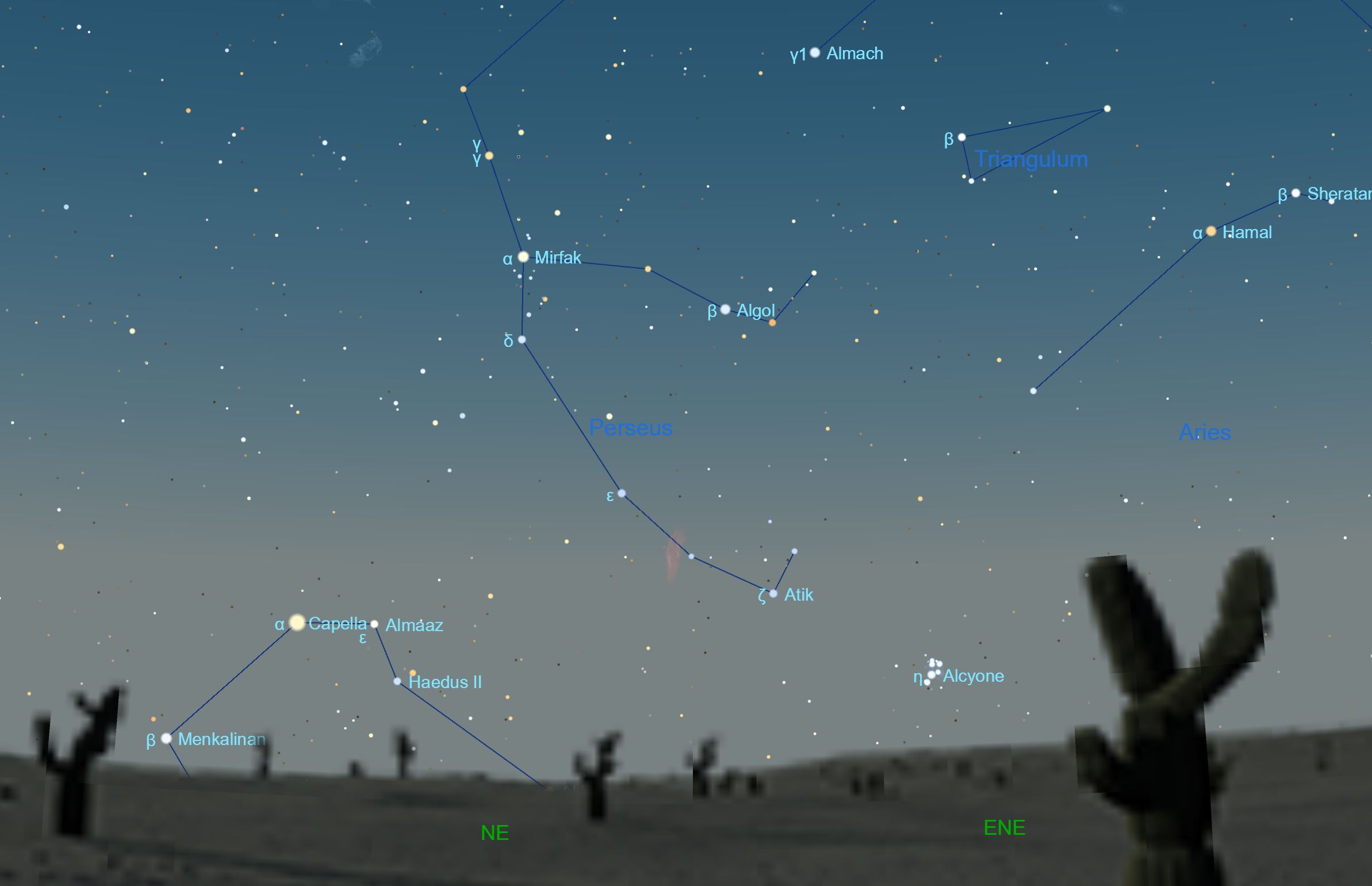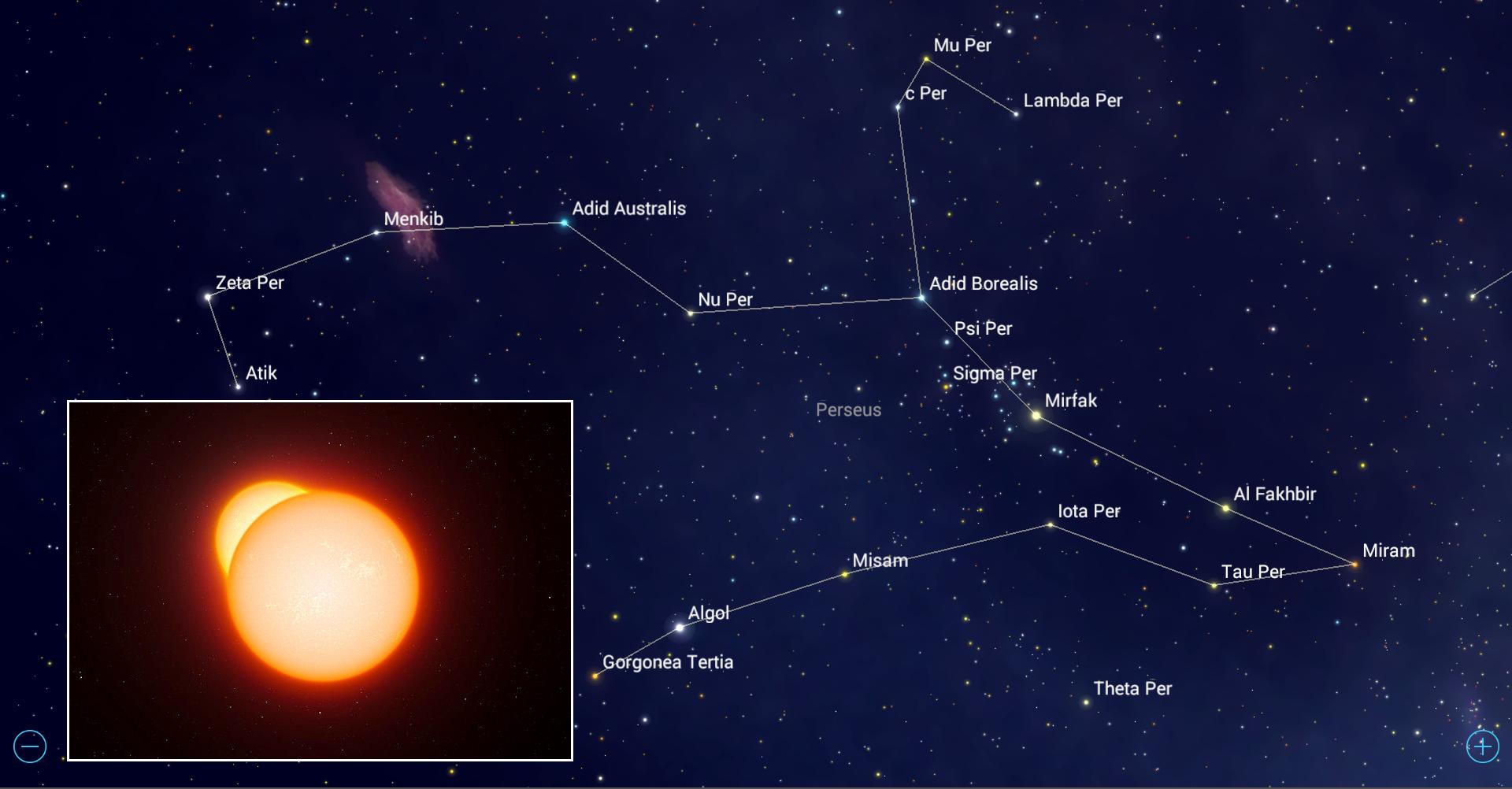Algol Star β Persei; +10 Facts, Myth, Features
- Home
- chevron_right
- Astronomy
- chevron_right
- Algol Star β Persei; +10 Facts, Myth, Features
Algol star, also known as Beta Persei, is a triple-star system located in the constellation Perseus. It is one of the most well-known variable stars in the night sky and has been studied by astronomers for centuries.
Algol star is composed of three stars: a bright, blue-white star known as Algol A, a smaller, yellow star known as Algol B, and a red dwarf known as Algol C. Algol A and Algol B orbit each other every 2.87 days, while Algol C orbits the other two stars at a much greater distance. The brightness of Algol appears to vary over time due to the eclipsing binary nature of Algol A and Algol B. As Algol A passes in front of Algol B, the system’s brightness decreases, making Algol appear fainter. This is known as the primary eclipse. When Algol B passes in front of Algol A, the brightness increases again, known as the secondary eclipse. The period of this variation is 2.87 days, which is the orbital period of Algol A and Algol B around each other. The depth of the primary eclipse is much greater than that of the secondary eclipse, indicating that Algol A is larger and more massive than Algol B.
The variations in the Algol star’s brightness were first discovered in 1667 by the Italian astronomer Geminiano Montanari, and the star has been studied extensively by astronomers ever since. Algol star has been used as a standard candle to measure distances to other stars. It has also been studied in detail to understand the properties and evolution of binary star systems.
+10 Important facts about the Algol Star
Here are some important facts about the Algol star system:
- Algol is located in the constellation Perseus and is visible to the naked eye as a single star.
- Algol star is a triple star system, consisting of a bright blue-white star (Algol A), a smaller yellow star (Algol B), and a red dwarf (Algol C).
- Algol A and Algol B orbit each other every 2.87 days, while Algol C orbits the other two stars at a much greater distance.
- The eclipsing binary nature of Algol A and Algol B causes variations in Algol’s brightness. As Algol A passes in front of Algol B, the brightness of the system decreases (primary eclipse), and when Algol B passes in front of Algol A, the brightness increases again (secondary eclipse).
- Algol’s brightness variations were first discovered in 1667 by the Italian astronomer Geminiano Montanari.
- The period of the Algol star’s brightness variations is 2.87 days, which is the same as the orbital period of Algol A and Algol B.
- The primary eclipse of Algol is much deeper than the secondary eclipse, indicating that Algol A is larger and more massive than Algol B.
- Astronomers have studied Algol extensively to understand the properties and evolution of binary star systems.
- Algol star is an important standard candle in astronomy, meaning its brightness variations can be used to measure distances to other stars.
- Algol is a relatively young star system, estimated to be around 80 million years old.
The Myth behind the Algol Star
Algol, also known as the “Demon Star”, has been associated with various myths and legends throughout history. One of the most well-known myths surrounding Algol comes from Arabic astronomy and mythology.
According to this myth, Algol represents the head of Medusa, the Gorgon from Greek mythology with snakes for hair, who could turn people to stone with her gaze. In the Arabic myth, Algol is seen as the eye of Medusa, and its variability is attributed to her winking. The Arabic name for Algol, “Ra’s al-Ghul”, means “the head of the ogre” or “the demon’s head”, which reflects the star’s association with evil in Arab culture. It was believed that the variability of Algol was caused by the demon’s head swallowing up the star, and then releasing it again.
The ancient Greeks also associated Algol with evil and misfortune. In Greek mythology, Algol was known as the “winking demon” or “blinking star”, and was seen as a symbol of the monstrous character of Medusa. It was believed that the star’s variability was caused by the struggle between Perseus, the hero who defeated Medusa, and Gorgon herself. Algol’s association with evil and misfortune has continued in modern times, and the star has been the subject of numerous science fiction and horror stories. Despite its ominous reputation, however, Algol remains an important object of study in astronomy and a fascinating example of the variability of the cosmos.
Summary
Algol star, also known as the Demon Star, is a triple-star system located in the constellation Perseus. Its brightness variations are caused by the eclipsing binary nature of Algol A and Algol B. Algol has been studied extensively by astronomers to understand binary star systems and is an important standard candle in astronomy. Algol is also associated with various myths and legends throughout history.
Reference:
Recent Posts
- What is Gravity?
- whirlpool galaxy (Messier 51); Facts, Location, Type
- Astronomy; Definition, Types, History and Facts
- Draco Constellation; Facts, Myth, Location, Stars
- Cassiopeia Constellation: Facts, Myth, Location, Stars
- Zodiac Constellations; Facts, Stars, Symbols, Dates, Signs
- Atik Star Omicron Persei; +10 Facts, Myth, Features
- Algol Star β Persei; +10 Facts, Myth, Features
Suggest Posts
- What is Gravity?
- whirlpool galaxy (Messier 51); Facts, Location, Type
- Astronomy; Definition, Types, History and Facts
- Draco Constellation; Facts, Myth, Location, Stars
- Cassiopeia Constellation: Facts, Myth, Location, Stars
- Zodiac Constellations; Facts, Stars, Symbols, Dates, Signs
- Atik Star Omicron Persei; +10 Facts, Myth, Features
- Algol Star β Persei; +10 Facts, Myth, Features
Categories

Nazanin Teymoori
Hi there, I am Nazanin, a member of the Aquilae Constellation team. And also the author of all the texts of this blog.
I am delighted that after many years of great interest in astronomy, I launched this website with the help of our professional team. We have many challenges ahead of us, but we promise ourselves that we will overcome everything.
I love astronomy So Let's go






